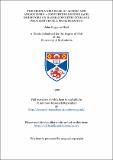The regulatory role of AcSDKP and angiotensin 1-converting enzyme (ACE) inhibitors on haematopoietic stem and progenitor cell proliferation
Abstract
Negative regulatory factors inhibit the proliferation of haematopoietic stem cells thus protecting them from differentiation pressures. One of the negative regulators of stem cell proliferation is the tetrapeptide Acetyl-Seryl-Aspartyl-Lysyl-Proline (AcSDKP). This peptide is endogenously produced in vivo and long term bone marrow cultures and is degraded by angiotensin 1-converting enzyme (ACE) both in vivo and in vitro. The aim of these investigations was to study the role of ACE on haematopoietic stem and progenitor cell proliferation. Since the N-domain ACE active has been implicated in AcSDKP degradation, an analysis of two ACE inhibitors (captopril and lisinopril) shown to have differential effects on the N-domain ACE active site was conducted. Both captopril and lisinopril equally reduced ACE activity in plasma in vitro. However, captopril had a lesser effect on reducing serum ACE activity in vitro than lisinopril. Captopril and AcSDKP together reduced the proportion of GM-CFC in S-phase after 7 hours of in vitro incubation. In addition, ACE resistant AcSDKP analogue (AcSDPψKP) when incubated with bone marrow cells in the absence of captopril also reduced the proportion of GM-CFC in S-phase. This finding suggest that the effect of captopril and AcSDKP on GM-CFC proliferation was due to AcSDKP alone. Haematopoietic stem cells were induced into cell cycle by in vivo administration of either 2 Gy-γ-irradiation or the two cytotoxic drugs, cytosine arabinoside (Ara-C) (100 mg/kg i.p.) or 5 flourouracil (5 FU) (150 mg/kg i.v). Bone marrow cells were sampled and incubated in vitro for up to 24 hours. Captopril together with AcSDKP reduced the proportion of high proliferative colony forming cells-1 (HPP-CFC-1) in S-phase following 2 Gy-γ-irradiation. Lisinopril together with AcSDKP had no such effect. In addition, captopril alone in vitro reduced the proportion of HPP-CFC-1 in S-phase induced into cell cycle by cytotoxic drugs. Lisinopril had no such effect. Incubation alone reduced the proportion of HPP-CFC-1 in S-phase in cytotoxic drug treated bone marrow cells. When cultures, which were incubated with captopril, were assayed for AcSDKP levels, captopril induced an increase in AcSDKP levels in both control normal bone marrow cells and cells derived from Ara-C treated mice. However, it did not affect AcSDKP levels in cultures derived from 5 FU and 2 Gy treated mice, AcSDKP together with captopril were shown to inhibit S-phase cell entry of HPP-CFC-1 when they were incubated with bone marrow cells derived from mice treated with either 2 Gy-γ-irradiation or cytotoxic drug insults. Interestingly, captopril was unable to reduce the proportion of SA2 leukaemic cells in S-phase Captopril on its own at therapeutic doses reduced the proportion of HPP-CFC- 1 in S-phase in vivo regardless of the insult used to induce HPP-CFC-1 into cell cycle. Lisinopril slightly reduced the proportion of HPP-CFC-1 in S-phase following Ai-a-C treatment only. Captopril induced an in vivo increase in AcSDKP levels in all the models tested. Captopril also reduced the proportion of HPP-CFC-1 and GM-CFC in S-phase following fractionated doses of Ara-C. Captopril's inhibitory effect on GM- CFC proliferation following fractionated dose of Ara-C was diminished after 7 days while it was sustained with HPP-CFC-1. Long-term bone marrow cultures revealed that captopril and AcSDxj/KP had the same effect on cellularities of both layers and on the proliferation of HPP-CFC and GM-CFC in both layers. From the present investigations, it can be concluded that captopril is a potent inhibitor of HPP-CFC-1 proliferation. This effect may in part be mediated by AcSDKP mechanism.
Type
Thesis, PhD Doctor of Philosophy
Collections
Items in the St Andrews Research Repository are protected by copyright, with all rights reserved, unless otherwise indicated.

